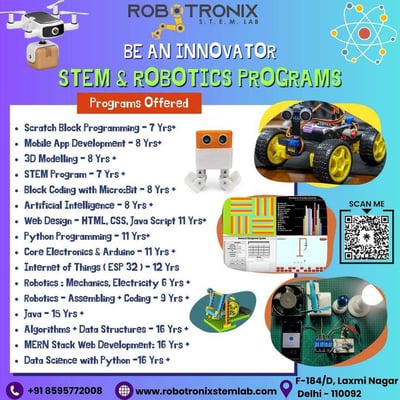Robotics classes for Kids - 31 options found
Robotics classes for children aged 2 to 15 offer numerous be... Robotics classes for children aged 2 to 15 offer numerous benefits, including stimulating brain development, fostering creativity, promoting collaboration, preparing for future careers in STEM fields, and building confidence and problem-solving skills. These classes introduce children to technology, engineering, and programming concepts through hands-on activities with robots, encouraging critical thinking and innovation. Children of all skill levels can participate, with opportunities to explore age-appropriate projects and programming languages. Robotics education provides a strong foundation for future learning and career opportunities in robotics, automation, and related fields, preparing children for success in the digital age. Read more
daffodils school-summer camp 2024
foxbrain-robotics classes
holy trinity summer camp 2024
wishful wings-kids summer camp
robotronix stem lab-steam & robotics program
holy trinity school-summer camp
bepic after school-robotics programme
the learning brush-robotics camp
skillful minds-summer smiles exclusive activities
the learning brush-summer camp
pratibhalaya-learn robotics
pathways early years-robotic program
Advantages of Robotics Classes for Children Ages 2 to 15
Introduction
Robotics classes offer children aged 2 to 15 an interactive and engaging way to learn about technology, engineering, and programming through hands-on activities with robots. These classes provide numerous benefits, including stimulating brain development, fostering creativity and problem-solving skills, promoting collaboration and teamwork, and preparing children for future career opportunities in STEM-related fields. In this guide, we will explore the advantages of robotics classes for children in this age range, along with addressing potential limitations and common questions.
Advantages
-
Stimulation of Brain Development:
- Cognitive Skills: Robotics classes challenge children to think critically, solve problems, and apply logical reasoning, which stimulates brain development and enhances cognitive skills such as planning, sequencing, and spatial awareness.
- Fine Motor Skills: Manipulating robots and assembling components require precise movements and coordination, promoting the development of fine motor skills and hand-eye coordination in young children.
-
Introduction to STEM Concepts:
- Technology and Engineering Principles: Robotics classes introduce children to fundamental concepts in technology, engineering, and physics through hands-on experimentation and observation. They learn about mechanisms, circuits, sensors, and other engineering principles in a practical and engaging manner.
- Programming Fundamentals: Children learn the basics of programming by coding robots to perform specific tasks or follow predefined instructions. This exposure to coding languages and algorithms lays the foundation for future learning in computer science and software development.
-
Creativity and Innovation:
- Design Thinking: Robotics classes encourage children to use their creativity and imagination to design, build, and customize robots according to their unique specifications and requirements. This fosters a sense of ownership and pride in their creations.
- Problem-Solving Skills: Robotics projects often present challenges and obstacles that require creative problem-solving and iterative design. Children learn to approach problems analytically, experiment with different solutions, and persist in the face of setbacks.
-
Collaboration and Teamwork:
- Group Projects: Many robotics classes involve collaborative projects where children work in teams to design and build robots. This fosters collaboration, communication, and teamwork skills as children learn to share ideas, delegate tasks, and work towards a common goal.
- Peer Learning: Collaborating with peers allows children to learn from each other's strengths and perspectives, fostering a sense of community and mutual support within the classroom.
-
Preparation for Future Careers:
- STEM Skills: Robotics classes equip children with valuable STEM skills that are in high demand in today's job market. These include critical thinking, problem-solving, coding, and engineering skills, which are essential for success in fields such as robotics, artificial intelligence, and automation.
- Career Exploration: Exposure to robotics at a young age can spark children's interest in STEM-related careers and fields, such as robotics engineering, computer science, aerospace, and mechatronics. Robotics classes provide a glimpse into these career paths and inspire children to pursue further education and training in STEM subjects.
-
Confidence Building:
- Success and Achievement: Completing robotics projects and seeing their robots in action boosts children's confidence and self-esteem, as they take pride in their accomplishments and problem-solving abilities.
- Risk-Taking: Robotics classes encourage children to take risks, try new things, and learn from failure. This resilience and willingness to experiment are essential skills that contribute to children's confidence and adaptability in various contexts.
Limitations
-
Resource Constraints:
- Equipment and Materials: Robotics classes require specialized equipment, such as robotics kits, sensors, and programming software, which may be costly and inaccessible to all students. Limited resources can constrain the types of projects and activities offered in robotics classes.
- Technical Support: Technical issues with robots or software may arise during classes, requiring troubleshooting and support from instructors. Lack of technical expertise or resources can hinder the learning experience for students.
-
Complexity of Concepts:
- Developmental Appropriateness: Some robotics concepts may be too complex for younger children to grasp, leading to frustration and disengagement. Careful consideration of age-appropriate content and scaffolding is necessary to ensure all children can participate and succeed in robotics classes.
- Programming Challenges: Programming robots requires understanding abstract concepts such as algorithms and debugging, which may be challenging for children with limited prior exposure to coding or computational thinking.
-
Diversity and Inclusion:
- Gender Disparities: Robotics classes may perpetuate gender stereotypes, with boys often dominating participation and leadership roles. Efforts to promote gender diversity and inclusion in robotics classes are essential to ensure equal opportunities for all children.
- Accessibility for Children with Disabilities: Robotics classes may not be fully accessible to children with disabilities, particularly those with physical or sensory impairments. Adapting curriculum and providing accommodations are necessary to make robotics education inclusive for all students.
Common Questions
-
At What Age Should Children Start Robotics Classes?
- Children can begin robotics classes as early as preschool, with age-appropriate activities that focus on basic concepts such as cause and effect, sequencing, and simple mechanical movements. As children grow older, they can progress to more complex projects and programming languages.
-
Do Children Need Prior Experience with Robotics or Coding?
- No prior experience is necessary for children to participate in robotics classes. Many programs offer beginner-level courses that introduce basic concepts and provide step-by-step instructions for building and programming robots. Children can learn and develop skills at their own pace, regardless of their prior experience.
-
How Can Parents Support Their Children's Learning in Robotics Classes?
- Parents can support their children's learning in robotics classes by encouraging experimentation and exploration, providing access to resources such as robotics kits and online tutorials, and engaging in discussions about robotics concepts and projects. Parents can also attend workshops or events with their children to further their understanding of robotics.
-
What Career Opportunities Are Available in Robotics?
- Careers in robotics span a wide range of industries and fields, including manufacturing, healthcare, agriculture, transportation, and entertainment. Job roles may include robotics engineer, software developer, automation specialist, roboticist, and research scientist. Robotics education provides a strong foundation for pursuing these career paths.
Conclusion
Robotics classes offer numerous advantages for children aged 2 to 15, including stimulating brain development, fostering creativity and innovation, promoting collaboration and teamwork, preparing for future careers in STEM fields, and building confidence and problem-solving skills. While there are limitations related to resource constraints, complexity of concepts, and diversity and inclusion, the benefits of robotics education outweigh the drawbacks. By providing engaging and hands-on learning experiences, robotics classes empower children to explore technology, engineering, and programming in a fun and interactive way, preparing them for success in the digital age.























